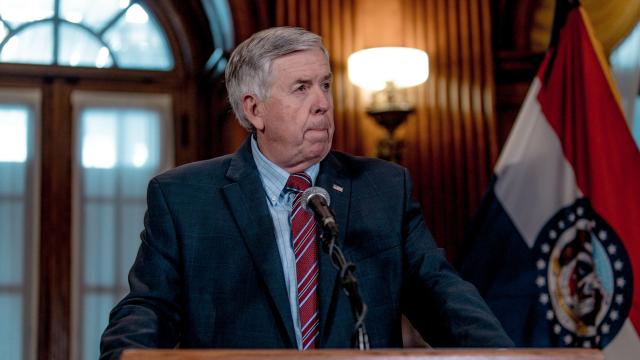While school districts across the nation are deciding if they want to return to in-person or distance learning in the fall, it seems like politicians remain decidedly split on the matter. While California Democratic Governor Gavin Newsom recently announced certain districts would not be allowed to re-open their schools due to the rise in positive covid-19 cases, Missouri GOP Governor Mike Parson thinks students should go back to in-person classes in the fall because they’ll just “get over” covid-19, Business Insider reports.
Gov. Paron was interviewed on The Marc Cox Morning Show July 17, where he discussed his views on the current pandemic, wearing masks, and sending kids back to school. “I don’t want anyone to think I’m anti-mask, because that’s not the case,” Paron says, “But I don’t think it’s the government’s place to tell everybody to do that.”
Parson goes on to say, “Kids are the least likely to have a problem with [covid-19]…These kids have got to get back to school. And if they do get covid-19, which they will — and they will when they go to school — they’re not going to the hospitals. They’re not going to have to sit in doctor’s offices. They’re going to go home and they’re going to get over it. And most of it proves to be that way if you look at the science of it.”
So Parson is totally ok with kids getting covid-19 when they go back to school, which are already incubation chambers for germs, the flu, and anything else that gets passed around from kids and staff not washing their hands or coming to school sick.
Parson did not say whether or not schools should have safety policies in place regarding masks, temperature checks, etc. But given that he feels it’s not the government’s place to tell people to wear masks, one has to wonder if he would even support school districts mandating that everyone on campus follow specific safety protocols.
While it’s not incorrect to say that kids don’t seem to be as affected by the virus, that only takes into account what we know about the virus up until this point. Children can and have died from covid-19, and immunocompromised children are at greater risk, much like adults. According to Bloomberg, recent state data from Arizona and Washington state show that 11% of total cases in those younger than 20. Tennessee is also 11% for ages 11-20. California is 8.4% and Mississippi is 9.4% in those younger than 18.
[referenced url=”https://gizmodo.com.au/2020/07/airborne-asymptomatic-and-other-misunderstood-coronavirus-terms/” thumb=”https://gizmodo.com.au/wp-content/uploads/2020/07/10/rd38oi7qrwwzlmwizosm-300×168.jpg” title=”‘Airborne,’ ‘Asymptomatic,’ and Other Misunderstood Coronavirus Terms” excerpt=”Today, the World Health Organisation formally announced a change in its stance over very two important issues concerning covid-19. The organisation stated that people can spread the virus while asymptomatic and that airborne transmission of the virus is possible under certain circumstances, such as crowded rooms with little ventilation.”]
The CDC website previously listed that rate at 2%, only updating it recently to show that covid-19 cases among ages 0-17 years old make up a total of 6.6% of cases across the U.S. The number is rising.
Florida recently reported that a little over 31% of the total number of kids under 18 in the state have tested positive for covid-19, according to official state data. Of a total of 23,170 positive cases, 246 kids were hospitalized. For Parson to say kids are “not going to the hospital” if they get covid-19 is not only completely false, but egregiously mistaken.
“Just because somebody doesn’t die from this doesn’t mean that something bad doesn’t happen to them,” said Jason Salemi, an epidemiologist at University of South Florida’s College of Public Health told Bloomberg. Other health problems that can linger long after the body has rid itself of the virus include blood clotting disorders, neurological complications, or other conditions.
Parsons also does not take into account that sending kids to school put adults, like teachers and administrators at risk of getting the virus, too. Looking at the same recently updated CDC data, adults aged 18-64 have almost the same chance of getting covid-19: 18-29 (20.4%), 30-39 (17%), 40-49 (16%), and 50-64 (22.5%).
According to an April 2020 publication by the Institute of Education Sciences, 29.2% of teachers in the U.S. are 50 and older. That means nearly one-third of teachers are at a higher risk of getting covid-19 than younger teachers. What happens when a teacher tests positive for covid-19 and has to quarantine for two weeks? Will the school find a substitute teacher to risk their health and take their place? Will all the students have to quarantine for two weeks as well? Or are kids and teachers supposed to keep coming to school if they display no symptoms? There are still some questions over whether the virus can be spread by asymptomatic individuals, and if it is spread via droplets or aerosols, but why put the teachers and students’ health at risk, regardless? Symptomatic or asymptomatic, you don’t just throw a sick kid into quarantine and tell them to take care of themselves — they will spread the virus.
While Missouri’s number of covid-19 cases is far less than California’s, a total of 35,821 compared to 393,740 as of July 19, 2020, that doesn’t change how the virus is spread, especially in a closed, indoor environment like a classroom. While there is some hope regarding a vaccine and the possibility that those who were previously infected will have longer-lasting immunity, we are still learning more about covid-19, and a vaccine is still a distant hope.
And while remote learning has understandably received a lot of criticism, and is one of the driving forces for this push to reopen schools, it wasn’t the teachers’ fault that some students received less than ideal instruction. Not only were teachers not prepared to teach through technology instead of only using it in their physical classrooms, not every school was able or willing to give its students computers or hotspots in a timely manner.
